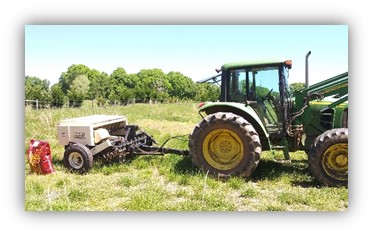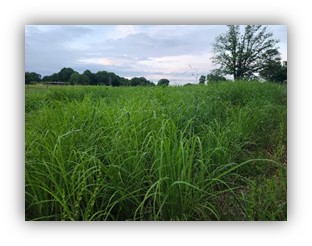In my career with USDA-NRCS I’ve been fortunate to see a lot of different production methods involving a variety of livestock operations across North Carolina. Beginning in 2016, I began working with more producers that had established or wanted to establish native warm-season grasses (NWSGs) in their pasture operations. Those producers mainly worked with beef cattle. These work experiences led me to want to do the same thing on our small 20-acre farm in North Carolina. However, I wanted to do something different by using sheep.
 Study Design
Study Design
My proposed theory was that I could use NWSGs to lower feed inputs on weaned lambs and achieve similar or better animal performance at the same time. Essentially another alternative to feed lotting weaned lambs for 60 days to avoid parasite burden. My plan was to measure animal performance by pounds of gain individually and as a contemporary group, as well as the need for deworming. FEC samples would be taken every two weeks on all the weaned lambs, but I would use FAMACHA score for treatment decisions. This was a two-year Southern SARE grant. The first year would be establishing the NWSG pasture plots, and then the second year would be to do the grazing study.
The two contemporary lamb groups would be split as evenly as possible by sex, birth type, and FEC EBV data. I had FEC data on previous lamb crops for 2020 and 2021, and I had pedigree FEC EBVs from some of the ewes I’d purchased from other flocks. It is also important to note that I used two NSIP sires for 2021 breeding with a large difference in WFEC and PFEC EBV data.
| Treatment | % Sire 1 | % Sire 2 | % Male | % Female | Birth Type |
| CS | 67 | 33 | 53 | 47 | 1.9 |
| WS | 53 | 47 | 47 | 53 | 1.8 |
Sire 1 had his lambing group EBVs for WFEC at -57 and PFEC -61. While Sire 2 had his lambing group EBVs for WFEC at 0 and PFEC at -16. Therefore, it was very important to mix the contemporary groups well to not bias the data per the Sire FEC EBVs. My NSIP flock average for WFEC is -22.25 and PFEC is -18.83. This is important data to reference as well to understand my ewe flock and their measured parasite resistance.
| Estimated Breeding Values | ||||
| Treatment | WFEC (%) | PFEC (%) | WWT (kg) | PWWT (kg) |
| CS | -40.0 | -48.3 | 2.0 | 2.7 |
| WS | -28.6 | -38.0 | 1.8 | 2.5 |
Grazing Study
In 2021, my first assignment with the SARE grant was to establish a test plot of NWSG. I planted the NWSG stand in May 2021, and did not graze it the entire growing season in an effort to establish the roots of the native plants. I was fortunate to have great technical assistance through the NC Wildlife Resources Commission to establish the NWSG stand. Jason Smith, District 7 Wildlife Biologist, delivered a No-Till Truax drill to use in establishing the NWSG mix of Big Bluestem, Little Bluestem, and Indiangrass.  I bush hogged the stand for a planned burn in Winter 2021 and let the ewe flock graze any dried forages remaining in the field in December 2021. Due to my inexperience and wet weather conditions, I was not able to burn the NWSG stand before 2022 grazing. No post-planting weed control was used in the NWSG pasture planting.
I bush hogged the stand for a planned burn in Winter 2021 and let the ewe flock graze any dried forages remaining in the field in December 2021. Due to my inexperience and wet weather conditions, I was not able to burn the NWSG stand before 2022 grazing. No post-planting weed control was used in the NWSG pasture planting.
One contemporary group was split into cool-season perennial pasture group with mainly a KY31 Tall Fescue base forage. These pastures are unimproved and haven’t been re-seeded since we bought the farm in 2018. Cool-season and warm-season annual weeds make up some of the pasture sward due to the marginal stand of cool-season perennial forages. Predominant annuals during the grazing phase of the study were Crabgrass, Plantain, Prickly Sida, and Dallisgrass. The other group was split into a NWSG group consisting of about 80% Big Bluestem, 5% Little Bluestem, and about 15% Indiangrass. There were some Ragweed and Horseweed plants in the pasture sward but overall, the NWSG stand was pretty well established with minimal weed pressure. No commercial fertilizer or organic fertilizer was applied to either pasture group during the entire study.
I started grazing the two groups of weaned lambs for the study on May 15th, 2022. Animals were moved daily or sometimes every other day to a new subdivision of pastures, depending on my work schedule. Weights were collected every two weeks and FAMACHA scores taken with the FEC samples. Dr. Weaver, NCSU Small Ruminant Specialist, was gracious enough to use his graduate student or himself to analyze the FEC sample submissions for the study. He was then used after the study to compile results for conclusion of the SARE grant. I very much appreciate his guidance and willingness to take phone calls while I was going through this grazing study.
 During the 8-week grazing study there was minimal rain, and we experienced a fairly dry Spring/Summer 2022. With minimal precipitation, the average recovery period before each group was re-grazing the same ground was 21 days. Fresh forage samples were taken from both stands to compare forage nutrient composition. NWSG stand composed of 12.65% Adjusted Crude Protein and 65.81% Total Digestible Nutrients. The cool-season pasture composed of 13.28% Crude Protein and 65.56% Total Digestible Nutrients. Both groups of weaned lambs were given a 18% protein tub free choice during the 8-week study as well.
During the 8-week grazing study there was minimal rain, and we experienced a fairly dry Spring/Summer 2022. With minimal precipitation, the average recovery period before each group was re-grazing the same ground was 21 days. Fresh forage samples were taken from both stands to compare forage nutrient composition. NWSG stand composed of 12.65% Adjusted Crude Protein and 65.81% Total Digestible Nutrients. The cool-season pasture composed of 13.28% Crude Protein and 65.56% Total Digestible Nutrients. Both groups of weaned lambs were given a 18% protein tub free choice during the 8-week study as well.
Conclusion
With my small 25 ewe flock I understood that I was looking more for trends in data and daily observation of the lambs, knowing that I wouldn’t have a huge dataset. My lambing rate was near 130% for 2022 Spring lambing and I experienced a lot of small lambs. I would attribute this to my lack of detail in 2021 Fall breeding due to the daily care of a family member with a terminal illness. Therefore, I only used 30 lambs for the total dataset. The intent was to see if I could find any positive or negative trends that would then maybe allow me to seek future SARE grants where I might try to include other Southern SARE producers to join with me in a larger study.
The results were mostly inconclusive in any trend. Essentially there was no difference in FEC results (eggs/gram) between lambs grazing cool-season and warm-season perennial pastures. There was no statistical difference in actual weights between cool-season and warm-season grazing lambs’ contemporary groups. At the beginning of the study both group FEC results were under 500 epg, but quickly escalated to near 3,000 epg average by July 8th, 2022 at the conclusion of the trial. No individual was over 7700 epg at any one time during the study.
One small difference was the number of lambs needing deworming. A greater proportion of lambs grazing cool-season grasses required deworming compared to those grazing NWSG pastures, with ~27% on cool-season and ~13% on NWSG pastures. North Carolina summers can be brutal on internal parasite burden to weaned lambs grazing forages. It was hard to try and wait until FAMACHA scores were a 4 to deworm mainly because I wanted to use as many lambs as possible for the end data results. Once a lamb was dewormed their FEC data and weight data were no longer used since they were no longer treated the same as the contemporary group. Weaned lambs were approximately 2 ½ months old when starting the grazing study, and it was found that they had no problems reaching the taller NWSG forage and stripping the forage from a higher growth point.
Due to the inconclusive results, I have agreed to do the study again in 2023 to provide at least two years of data. We did host a field day in August 2022 to share our results with local producers and gain any valuable insight from other breeders with possible improvements to the study. We had nearly 50 participants join the in-person meeting at the farm. I will work with Dr. Weaver again to submit fecal samples and welcome any feedback on how I could perform the study even better in 2023. I enjoyed the study, but realized how difficult it is to control Mother Nature with lack of precipitation and then poor breeding management on my end as the Shepherd. I’ve been able to pay more attention to Fall 2022 breeding program and flushed the ewes with some grain before breeding began in October 2022. I look forward to sharing any further results that we may find in 2023 to help pasture-based Katahdin operations in the Eastern United States. I want to give a special thanks to Dr. Andrew Weaver, NCSU Small Ruminant Specialist, for helping with the FEC samples and statistical analysis. Also, a huge thanks to Jason Smith, NCWRC Wildlife Biologist, for his assistance with the NWSG planting and implementation.
By: Lee Holcomb, EAPK Member
![]()


